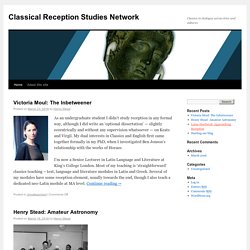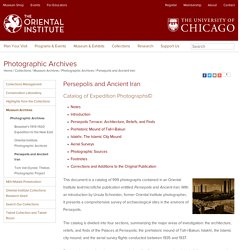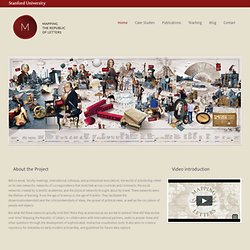

Classics in dialogue across time and cultures. Victoria Moul: The Inbetweener As an undergraduate student I didn’t study reception in any formal way, although I did write an ‘optional dissertation’ — slightly eccentrically and without any supervision whatsoever — on Keats and Virgil.

My dual interests in Classics and English first came together formally in my PhD, when I investigated Ben Jonson’s relationship with the works of Horace. I’m now a Senior Lecturer in Latin Language and Literature at King’s College London. Most of my teaching is ‘straightforward’ classics teaching – text, language and literature modules in Latin and Greek. Several of my modules have some reception element, usually towards the end, though I also teach a dedicated neo-Latin module at MA level. Henry Stead: Amateur Astronomy Not many people know this, but I’ve recently become pretty obsessed with the night sky. Lorna Hardwick: Approaching Reception I’m often asked about how and when I got involved in classical reception research. Starting our blog. The Oriental Institute of the University of Chicago. Catalog of Expedition Photographs© This document is a catalog of 999 photographs contained in an Oriental Institute text/microfiche publication entitled Persepolis and Ancient Iran.

With an introduction by Ursula Schneider, former Oriental Institute photographer, it presents a comprehensive survey of archaeological sites in the environs of Persepolis. The catalog is divided into four sections, summarizing the major areas of investigation: the architecture, reliefs, and finds of the Palaces at Persepolis; the prehistoric mound of Tall-i-Bakun; Istakhr, the Islamic city mound; and the aerial survey flights conducted between 1935 and 1937.
Each section describes the vast accumulation of artifacts uncovered and the buildings reconstructed out of the ruins of this ancient Persian capital. In addition, the expedition's aerial survey explorations are detailed, which constituted an important contribution to archaeological research techniques. Acknowledgements. Anabases - Traditions et réceptions de l’Antiquité. Bulletin of the History of Archaeology. Consulta del Catálogo. Catálogo Colectivo delPatrimonio Bibliográfico Español Contacto con el Catálogo Colectivo del Patrimonio Bibliográfico.

Seminar on Collecting and Display. HISTORIADORES Y GENTES DE LETRAS EN LOS SIGLOS DE ORO. Esta página de la web es uno de los resultados del Proyecto de Investigación "La escritura del recuerdo en primera persona: diarios, memorias y epistolarios de reyes, embajadores y cronistas (siglos XVI-XVII)" con nro. de ref.

HAR2011-30251 (en ciernto modo una ampliación de “El Pasado, un laboratorio de experiencias: historias e identidades (Pastlab)”, nro. de ref. HAR2008-01594) financiado por el Ministerio de Economía y Competitividad y que bajo la dirección del dr. Alfredo Alvar Ezquerra se realiza en la Línea de Investigación “Historia social del poder” en el Centro de Ciencias Humanas y Sociales de la Agencia Estatal Consejo Superior de Investigaciones Científicas.En la columna de la izquierda -"Autores"-, vamos a ir incluyendo las biografías y escritos de los historiadores más importantes de la Alta Edad Moderna, sobre todo los cronistas reales, o sus autores de referencia e inspiración. N. Mapping the Republic of Letters. About the Project Before email, faculty meetings, international colloquia, and professional associations, the world of scholarship relied on its own networks: networks of correspondence that stretched across countries and continents; the social networks created by scientific academies; and the physical networks brought about by travel.

These networks were the lifelines of learning, from the age of Erasmus to the age of Franklin. They facilitated the dissemination&emdash;and the criticism&emdash;of ideas, the spread of political news, as well as the circulation of people and objects. But what did these networks actually look like? Were they as extensive as we are led to believe? Histories of Archaeology Research Network Weblog. SEHA. Almahisto - El Almacen de la Historia « Recopilación de fuentes historiográficas del 1700 al 1939. ANTICUARIUS. Ganso y Pulpo. Secuencia de fotos de The British Library. Classical Receptions Journal. Bulletin of the History of Archaeology. La tradizione classica nella memoria occidentale n.110. Tradición Clásica. Historia cultural de los estudios clásicos en España (1713-1939) Últimas tendencias de la historiografía española 1/9. Biblioteca Virtual de Prensa Historica > Búsqueda.
Possessing the Past: Themes in Historiography. THE WARBURG INSTITUTE: Home. Biblioteca Manes. Página Principal. Historiografía: La Invención de la Memoria.